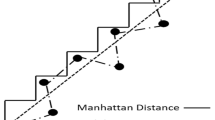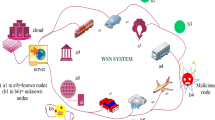Abstract
Nowadays, different types of computer networks such as Wireless sensor networks (WSNs), the Internet of things (IoT), and wireless body area networks (WBANs) transfer information, share resources, and process information. The IoT is a novel network which interconnects various smart devices and can consist of heterogeneous components such as WSNs for monitoring and collecting information. Characterized by specific advantages, the IoT contains different types of nodes, each with few sensors to collect environmental information on agriculture, ecosystem, search and rescue, conflagrations, etc. Despite extensive applications and high flexibility in the modern world, the IoT faces specific challenges, the most important of which include routing, energy consumption and localization. Localization leads to other network challenges and thus can be considered the most important challenge in the IoT. Localization refers to a process aiming at determining the positions and locations of objects lacking global positioning system (GPS) and needing to use the information of network sensors and topology to estimate their own positions and locations. The distance vector hop (DV-Hop) algorithm is a range-free localization technique, in which the major challenge is that the number of hops between two nodes is multiplied by a number that is the same for all nodes leading to a significant reduction in the localization accuracy. In the method proposed in this paper, a network node with no GPS determines the hops from three anchor nodes with GPS. The location of smart objects can be then estimated according to distances from those anchor nodes. Thereafter, a few positions can be created nearby to mitigate the error. Then each position can be regarded as a member of the grasshopper optimization algorithm (GOA) to minimize the localization error. According to the results obtained from implementation of the proposed algorithm, it is characterized by a lower localization error than grasshopper optimization, butterfly optimization, firefly and swarm optimization algorithms.

















Similar content being viewed by others
Data Availability
All data generated or analysed during this study are included in the manuscript.
Code Availability
Not applicable.
References
Shit, R. C., Sharma, S., Puthal, D., James, P., Pradhan, B., van Moorsel, A., … Ranjan,R. (2019). Ubiquitous Localization (UbiLoc): A Survey and Taxonomy on Device Free Localization for Smart World. IEEE Communications Surveys & Tutorials.
Saeed, N., Celik, A., Al-Naffouri, T. Y., & Alouini, M. S. (2019). Localization of energy harvesting empowered underwater optical wireless sensor networks. IEEE Transactions on Wireless Communications, 18(5), 2652–2663.
Wang, H., Wen, Y., Lu, Y., Zhao, D., & Ji, C. (2019). Secure localization algorithms in wireless sensor networks: a review. Advances in Computer Communication and Computational Sciences (pp. 543–553). Singapore: Springer.
Balico, L. N., Loureiro, A. A., Nakamura, E. F., Barreto, R. S., Pazzi, R. W., & Oliveira, H. A. (2018). Localization prediction in vehicular ad hoc networks. IEEE Communications Surveys & Tutorials, 20(4), 2784–2803.
Nath, R. K., Bajpai, R., & Thapliyal, H. (2018, January). IoT based indoor location detection system for smart home environment. In 2018 IEEE International Conference on Consumer Electronics (ICCE) (pp. 1–3). IEEE.
Huang, J., Zhao, Y., Li, X., & Xu, C. Z. (2019, June). Ultra-Low Power Localization System Using Mobile Cloud Computing. In International Conference on Cloud Computing (pp. 1–10). Springer, Cham.
Mahmud, R., Kotagiri, R., & Buyya, R. (2018). Fog computing: a taxonomy, survey and future directions. Internet of everything (pp. 103–130). Singapore: Springer.
Nicolalde, F. C., Silva, F., Herrera, B., & Pereira, A. (2018, March). Big Data Analytics in IOT: Challenges, Open Research Issues and Tools. In World Conference on Information Systems and Technologies (pp. 775–788). Springer, Cham.
Vatansever, Z., Brandt-Pearce, M., & Bezzo, N. (2019, May). Localization in Optical Wireless Sensor Networks for IoT Applications. In ICC 2019.
Wu, H., Ding, Z., & Cao, J. (2019). GROLO: Realistic Range-based Localization for Mobile IoTs through Global Rigidity.IEEE Internet of Things Journal.
Dang, L., Yang, H., & Teng, B. (2018). Application of Time-Difference-of-arrival localization method in Impulse System Radar and the Prospect of Application of Impulse System Radar in the internet of things. Ieee Access : Practical Innovations, Open Solutions, 6, 44846–44857.
Sadowski, S., & Spachos, P. (2018). Rssi-based indoor localization with the internet of things. Ieee Access : Practical Innovations, Open Solutions, 6, 30149–30161.
Van Der Vorst, T., Van Eeckhaute, M., Benlarbi-Delaï, A., Sarrazin, J., Quitin, F., Horlin, F., & De Doncker, P. (2019).Application of Polynomial Chaos Expansions for Uncertainty Estimation in Angle-of-Arrival Based Localization.
Arora, S., & Anand, P. (2019). Chaotic grasshopper optimization algorithm for global optimization. Neural Computing and Applications, 31(8), 4385–4405.
Yaqoob, I., Hashem, I. A. T., Ahmed, A., Kazmi, S. A., & Hong, C. S. (2019). Internet of things forensics: recent advances, taxonomy, requirements, and open challenges. Future Generation Computer Systems, 92, 265–275.
Miraz, M., Ali, M., Excell, P., & Picking, R. (2018). Internet of nano-things, things and everything: future growth trends. Future Internet, 10(8), 68.
Motta, R. C., de Oliveira, K. M., & Travassos, G. H. (2019, June). A framework to support the engineering of internet of things software systems. In Proceedings of the ACM SIGCHI Symposium on Engineering Interactive Computing Systems (p. 12). ACM.
Pardini, K., Rodrigues, J., Kozlov, S., Kumar, N., & Furtado, V. (2019). IoT-Based solid Waste Management Solutions: a Survey. Journal of Sensor and Actuator Networks, 8(1), 5.
Khodadadi, F., Dastjerdi, A. V., & Buyya, R. (2017). Internet of Things: An Overview. arXiv preprint arXiv:1703.06409.
Khelifi, F., Bradai, A., Benslimane, A., Rawat, P., & Atri, M. (2019). A survey of localization systems in internet of things. Mobile Networks and Applications, 24(3), 761–785.
Saad, E., Elhosseini, M., & Haikal, A. Y. (2018). Recent achievements in sensor localization algorithms.Alexandria engineering journal.
Jeong, J. P., Yeon, S., Kim, T., Lee, H., Kim, S. M., & Kim, S. C. (2018). SALA: smartphone-assisted localization algorithm for positioning indoor iot devices. Wireless Networks, 24(1), 27–47.
Lu, B., Wang, L., Liu, J., Zhou, W., Guo, L., Jeong, M. H., … Han, G. (2018). LaSa:Location Aware Wireless Security Access Control for IoT Systems. Mobile Networks and Applications, 1–13.
Sotenga, P. Z., Djouani, K., Kurien, A. M., & Mwila, M. M. (2017). Indoor localisation of wireless sensor nodes towards internet of things. Procedia Computer Science, 109, 92–99.
Hamdani, M., Qamar, U., Butt, W. H., Khalique, F., & Rehman, S. (2018, November). A Comparison of Modern Localization Techniques in Wireless Sensor Networks (WSNs). In Proceedings of the Future Technologies Conference (pp. 535–548). Springer, Cham.
Gumaida, B. F., & Luo, J. (2019). Novel localization algorithm for wireless sensor network based on intelligent water drops. Wireless Networks, 25(2), 597–609.
Kumar, S. (2019). Performance Analysis of RSS-Based Localization in Wireless Sensor Networks.Wireless Personal Communications,1–15.
Kumar, P. M., Manogaran, G., Sundarasekar, R., Chilamkurti, N., & Varatharajan, R. (2018). Ant colony optimization algorithm with internet of vehicles for intelligent traffic control system. Computer Networks, 144, 154–162.
Wang, P., Xue, F., Li, H., Cui, Z., Xie, L., & Chen, J. (2019). A multi-objective DV-Hop localization algorithm based on NSGA-II in internet of things. Mathematics, 7(2), 184.
Bae, Y. (2019). Robust localization for Robot and IoT using RSSI. Energies, 12(11), 2212.
Cao, Q., Yu, L., Wang, Z., Zhan, S., Quan, H., Yu, Y., … Koubaa, A. (2021). Wild Animal Information Collection Based on Depthwise Separable Convolution in Software Defined IoT Networks. Electronics, 10(17), 2091.
Chen, Z., Sivaparthipan, C. B., & Muthu, B. (2022). IoT based smart and intelligent smart city energy optimization. Sustainable Energy Technologies and Assessments, 49, 101724.
Maram, B., Gnanasekar, J. M., Manogaran, G., & Balaanand, M. (2019). Intelligent security algorithm for UNICODE data privacy and security in IOT. Service Oriented Computing and Applications, 13(1), 3–15.
Ewees, A. A., Elaziz, M. A., & Houssein, E. H. (2018). Improved grasshopper optimization algorithm using opposition-based learning. Expert Systems with Applications, 112, 156–172.
Saremi, S., Mirjalili, S., & Lewis, A. (2017). Grasshopper optimisation algorithm: theory and application. Advances in Engineering Software, 105, 30–47.
Mirjalili, S. Z., Mirjalili, S., Saremi, S., Faris, H., & Aljarah, I. (2018). Grasshopper optimization algorithm for multi-objective optimization problems. Applied Intelligence, 48(4), 805–820.
Arora, S., & Singh, S. (2017). Node localization in wireless sensor networks using butterfly optimization algorithm. Arabian Journal for Science and Engineering, 42(8), 3325–3335.
Funding
No funds, grants were received by any of the authors.
Author information
Authors and Affiliations
Contributions
Shakir Mahmood Al Janabi and Sefer Kurnaz. contributed to the design and methodology of this study, the assessment of the outcomes and the writing of the manuscript.
Corresponding author
Ethics declarations
Conflict of Interest
There is no conflict of interest among the authors.
Additional information
Publisher’s Note
Springer Nature remains neutral with regard to jurisdictional claims in published maps and institutional affiliations.
Rights and permissions
Springer Nature or its licensor (e.g. a society or other partner) holds exclusive rights to this article under a publishing agreement with the author(s) or other rightsholder(s); author self-archiving of the accepted manuscript version of this article is solely governed by the terms of such publishing agreement and applicable law.
About this article
Cite this article
Janabi, S.M.A., Kurnaz, S. A new localization mechanism in IoT using grasshopper optimization algorithm and DVHOP algorithm. Wireless Netw (2023). https://doi.org/10.1007/s11276-023-03247-2
Accepted:
Published:
DOI: https://doi.org/10.1007/s11276-023-03247-2




